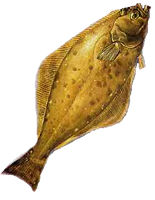Fish 'n Chip Paper
 The Times Colonist has always had an interesting variety of columnists, because there are so many good writers in this town. I've become a tremendous admirer of Jack Knox, who always comes up with creative and funny ways to report news. But in today's paper the most interesting piece was by D.C. Reid, the fishing writer, who created a concise how-to guide on catching the Pacific halibut – a meaty local fish I've only ever trapped with capers and lemon.
The Times Colonist has always had an interesting variety of columnists, because there are so many good writers in this town. I've become a tremendous admirer of Jack Knox, who always comes up with creative and funny ways to report news. But in today's paper the most interesting piece was by D.C. Reid, the fishing writer, who created a concise how-to guide on catching the Pacific halibut – a meaty local fish I've only ever trapped with capers and lemon.
Here's part of Reid's column, which packs more practical info and colourful language about "flatties" into 800 words than you'd ever get from a biologist:
Halibut are migratorial, moving as much as 1,600 kilometres from the deep (5,000 feet) to onshore in late winter to spawn, then moving out, only to reappear in May and stay until the early days of September. There are also halibut that do not migrate. For example, divers sometimes spot 50-pound halibut beneath the Oak Bay Marina floats in the winter.So if the apocalypse descends, now you can catch a halibut. Assuming, of course, that you've got homemade pipe bombs with a hootchy skirt.
Their migratorial nature influences halibut to eat more – because of the energy expended – and their territorial nature influences their distribution. Each time you receive a bite, hit a GPS waypoint immediately. Halibut return to the same rockpile, canyon edge, bump or spire again and again; this is why guides do not give out waypoints and don't want clients bringing GPSs. Halibut sort by size, too; where you catch the smaller 'chickens' you will continue catching chickens; where you catch biggies you will continue catching biggies.
Remember that halibut have extraordinary nasal, auditory and visual perception. Hence you fish with natural bait, such as herring, mackerel, and octopus. Always put a tentacle of tough octopus on one hook so that if the softer bait is nabbed, there is still scented bait to attract a second pass. Some people resort to putting out scented rags tied around rocks to draw the big fish.
If fishing with jigs such as Mudrakers, Lugky Jigs and homemade pipe bombs with an added hootchy skirt, always drizzle them with scent, such as Charlie White's X-Ten, or Smelly Jelly or use the eight-inch White Berkley Powerbait Grubs that have scent and are tough enough to be reused. Once your lure hits the bottom, thunk-thunk it every 30 seconds or so to send out vibration. Halibut read this as prey in trouble and streak in to investigate.
Once the target is sighted – get glow-in-the-dark and ultraviolet lures working for you in the deep – the halilbut snatches the bait. At this point nasal cues are more important than visual cues and the halibut follows its nose in the last few feet like a shark that closes eyelids, making it safe but blind during the strike.
As for where you catch halibut, look for changes in bottom contours. The 140-foot toe on Constance Bank [six miles south of Clover Point] is a good example, being an apron below the 60-foot flat above, and a table before the water drops to 300 feet on most every side. Do note that there are more halibut out there than one would think.


2 Comments:
I was salivating until I read how these bottom-feeders like to hang out south of Clover Point. :p
Exactly. Do we want to eat anything that swims with Mr. Floatie? Not I!
Post a Comment
<< Home